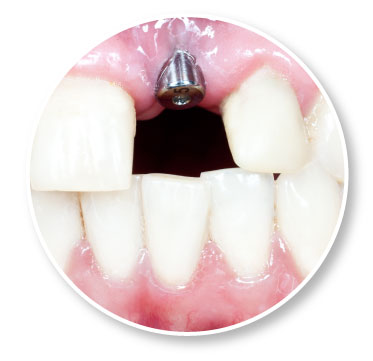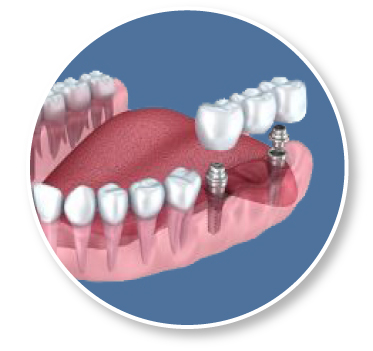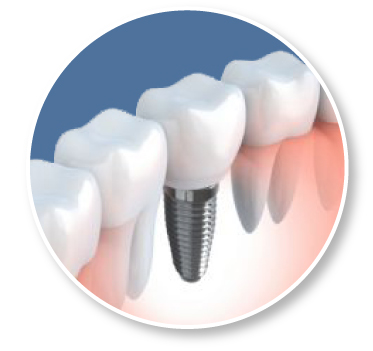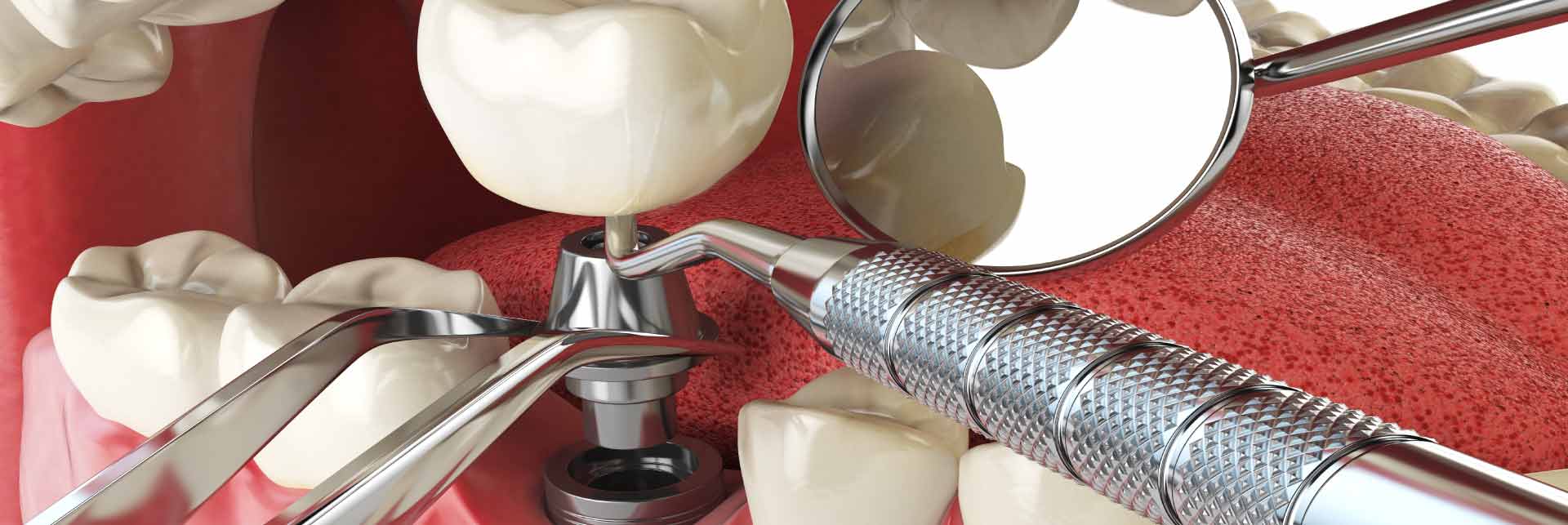What Are Dental Implants?
A healthy smile plays a vital role in the way you look and feel, but millions of people are affected by a change in appearance and health due to missing teeth. Fortunately, the innovation of dental implants is available as an optimal solution for tooth replacement that can help replace the look and function of your natural teeth. By acting as substitute tooth roots, dental implants provide a stable foundation for replacement teeth that stay securely in place, allowing you to eat, speak and smile with confidence.
For over forty years, dental implants have been used successfully as a treatment option to permanently replace one or more missing teeth, as well as all teeth in the lower and upper jaws. Dental implants are small screws made of titanium, a metal accepted by the body and well documented for its ability to heal together with bone tissue. Once placed in the jawbone, dental implants act as artificial tooth roots that provide a stable base for single tooth crowns, larger bridges or dentures.
Parts of a Dental Implant

Implant: The root for the new tooth
The titanium screw that is inserted into the jawbone to form the foundation of new tooth is referred to as the “dental implant.” The length and diameter of the dental implant used can vary depending on the amount of bone present and the jaw size of each individual patient.

Abutment: Post for the new crown
The abutment is made of either titanium or ceramic and is attached to the implant to create a post, which the new crown is attached to and supported by.

Restoration: The finished product
Once the dental implant and the abutment are in place in either the lower or upper jaw, the crown, bridge or full prosthesis can then be securely attached in place for a tooth replacement that looks, feels, and functions just like natural teeth.
This dental implant technique involves the removal of bad teeth, placement of dental implants and beautiful new teeth in one appointment. Working with your family dentist, that you know and trust, computer pre-planning allows for all the surgical procedures to be done in one visit. Patients leave with new teeth attached to the implants the same day. This process requires us to obtain a 3D scan of the jaws at the consultation visit to diagnose the problem and provide counseling on what can be done to restore a beautiful smile.
Replacing All Teeth Permanently
Implants can support an entire arch of upper or lower replacement teeth that are fixed into the mouth and are never removed. Sometimes the new teeth can be supported by as few as 4 implants. It’s comparable to the structure of a table, which only needs 4 legs to hold it up. In cases where jawbone density and volume have deteriorated, 5 or 6 implants might be needed to support a row of 10 to 12 teeth. Dental implant replacement teeth protect your jawbone, won’t slip, and should last a lifetime.
All Teeth – Fixed
Step 1
If you have lost all of your teeth in one or both of jaws and require the most natural looking solution, the permanently anchored dental implant bridge on several dental implants is the answer when the prerequisites are met.
Step 2
For a permanently anchored dental implant bridge, several dental implants are installed to form a good foundation. Because the dental implants are anchored in the jawbone, they stimulate the bone tissue and help to maintain healthy bone levels and facial structures.
Step 3
The abutments are attached to the dental implants and the bridge is fitted in place. All dental work is performed according to your prerequisites and wishes.
Step 4
The dental implant bridge is now in place. It looks and functions like normal teeth. You can now eat whatever you like and laugh without having to worry about the prosthesis falling out.

Replacing Multiple Teeth
When you have more than one tooth missing, implants provide an ideal replacement mechanism. You don’t even need one implant for every missing tooth. Instead, implant teeth can act as supports for fixed bridgework. For example, if you are missing three teeth in a row, we can place two implants, one on either side of the gap, and a crown in between that has no implant underneath. That way, you won’t need to use any of your remaining natural teeth as bridge supports, which could weaken them and make them more susceptible to decay.
Step 1
Some people loose teeth in the back of the mouth. This is typically caused by gum infection (periodontitis) or by teeth cracking due to previous fillings.
Step 2
Between two and four dental implants are installed for a dental implant bridge. This solution does not affect your own teeth. The bridge will function for many years, regardless of the condition of your existing teeth.
Step 3
Abutments are attached to the dental implants. The next step is to fit a bridge; the new set of teeth is placed on the abutments. Step 4 The dental implant bridge is now in place and can withstand the strong chewing forces that occur in the back of the mouth. It feels and functions like natural teeth.
Step 4
The dental implant bridge is now in place and can withstand the strong chewing forces that occur in the back of the mouth. It feels and functions like natural teeth.

Replacing One Tooth
When you have one tooth missing, a single implant is inserted into the bone to replace the root part of that tooth; a crown then goes on top to simulate an actual tooth. This treatment choice has the highest success rate, making it the best long-term investment for replacing a single missing tooth. Even if the initial cost is slightly higher than other options, it is the most cost-effective solution over time. An implant will never decay or need root canal treatment, and feels just like the tooth that was there.
Step 1
The need to replace a missing tooth could be the result of an accident or because there was no predisposition for a tooth at birth.
Step 2
The dental implant is installed in the jawbone. No healthy teeth are affected or damaged. With other replacement solutions, adjacent teeth might need to be ground down to support a bridge.
Step 3
The abutment is attached to the dental implant. A crown is then placed on the abutment, fitting perfectly at the edge of the gum.
Step 4
The new tooth is now complete and it is virtually impossible to see the difference between the existing teeth and the new tooth.
- Stable and permanent tooth replacement option that look, feel and function like natural teeth.
- Healthy, adjacent teeth do not need to be ground down for support.
- Anchoring dental implants in the jawbone stimulates bone tissue and gums, ensuring an attractive, esthetic result, while helping to maintain facial structures.
- Dental implants do not require any messy adhesives to hold the teeth in place, and eliminate discomfort and insecurity of loose, ill-fitting dentures.
- Replacing missing teeth with dental implants can allow you to smile with confidence and eat the foods you enjoy again.
- Dental implants are helping to improve the quality of life for millions of people.
Step 1: A thorough examination
The first step in dental implant therapy is a discussion with your dental professional, followed by a thorough dental examination. The jaw is x-rayed to check the condition of the bone tissue and to determine the placement of the dental implant. An impression is made of the jaw and existing teeth, forming an important platform for the treatment.
Step 2: Inserting the dental implant
There are two options for dental implant placement depending on your clinical situation. In a one-step procedure, the dental implant is put in place and a temporary abutment is attached. In a two-step procedure, the dental implant is installed and then covered by the gum. The abutment is attached at a later date. In both cases, a temporary tooth or prosthesis is put in place, followed by a maximum healing period of three months for the lower jaw and six months for the upper jaw. In some cases, the dental implant can be loaded immediately although this depends on your bone condition.
Step 3: Attaching the abutments
In a one-step procedure, the temporary abutment is replaced by a permanent one after the dental implant has bonded with the bone tissue. The second part of a two-step procedure involves making a minor incision to open the gum and put the abutment in place.
Step 4: Producing the teeth
When the abutment is in place, a new impression is made. It is then compared with the impression made during the initial examination. Based on a final model, a dental technician carefully crafts the crown, bridge or prosthesis. Special attention is given to ensuring the right color and shape so that your new teeth look like your natural teeth.
Step 5: Fitting and re-examination
When the teeth are ready, your dental professional simply attaches them to the dental implants. This is usually followed by a few follow-up visits to check functionality and esthetics and to make sure you are completely satisfied with your new teeth.
Step 6: Healing period
When you are ready for a dental implant, you will have a solution tailored to your needs, general state of health and the quantity and quality of your bone tissue. These factors also determine the total duration of the treatment. Consult your dental professional for your specific options.
There are only two ways an implant can lose attachment to the bone and fail once it has successfully fused: poor oral hygiene or excessive biting forces. Poor oral hygiene and/or a lack of regular cleanings can lead to a destructive bacterial infection called peri-implantitis. Flossing and brushing your teeth on a daily basis, along with regular professional cleanings, can prevent this. Excessive biting forces can come from either a habit of clenching or grinding your teeth, or an insufficient number of implants to handle the forces generated by your bite. You should receive the correct number of implants so this does not happen. And if you have a habit of grinding or clenching your teeth, a night guard will be recommended to protect your implants. After all, implants are a long-term investment in your smile, your health and your well-being, so it’s best to protect your investment.
Implants that Support Removable Dentures
Implants can even make removable dentures more comfortable, effective and healthier to wear. Traditional dentures rest on the gums and put pressure on the underlying bone. This accelerates bone loss so that the jaw shrinks and the dentures slip, particularly on the bottom. But today dentists can attach a removable denture onto implants, transferring that pressure into the bone structure rather than the bone surface. This prevents the dentures from slipping while you eat and speak, and preserves the bone directly beneath them.
All Teeth – Removable
Step 1
If you have lost all of your teeth in one or both jaws and require a removable prosthesis that remains in place more firmly than a conventional removable prosthesis, the overdenture connected to two or more implants is the answer when the prerequisites are met.
Step 2
An overdenture involves installing two or more dental implants that will be used as a secure foundation to attach the prosthesis.
Step 3
For the overdenture, either ball abutments or a small bar between the abutments are used. The prosthesis is fitted with corresponding devices underneath.
Step 4
The overdenture is now in place. It looks and functions like normal teeth. You can now eat whatever you like and laugh without having to worry about the prosthesis falling out.

